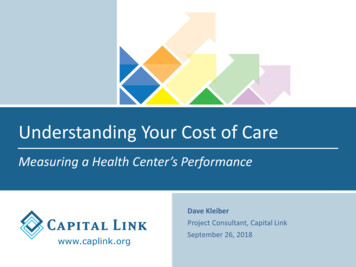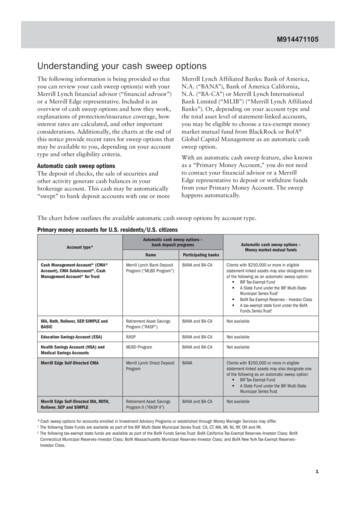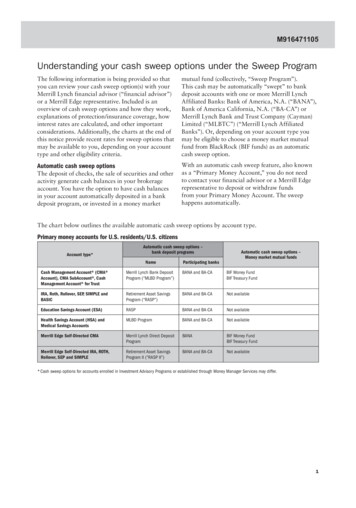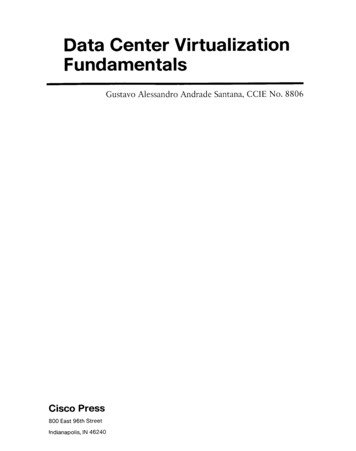
Transcription
alysisDIALYSISOPTIONSAccess Options
HOW THE KIDNEYS WORKInside each nephron, a special bloodvessel called a glomerulus works likea strainer to keep blood cells andneeded substances in while lettingextra fluid and wastes out.Blood enters the kidney here,through the renal artery.Each kidney contains about onemillion nephrons - tiny filteringcenters that clean the blood.Drop by drop, urine is produced andtravels to the bladder through thistube, called a ureter.
UNDERSTANDING YOURPERITONEAL DIALYSIS OPTIONSThe kidneys are two bean-shapedorgans, each about the size of afist. They are located just belowthe rib cage, one on each side ofthe spine. To locate your kidneys,put your hands on your hips, andthen slide your hands up until youcan feel your ribs. Now if you putyour thumbs on your back, youwill know where your kidneys are.You can’t feel them, but they arethere.WHAT DO THEKIDNEYS DO? Regulate your blood pressure Make red blood cells Keep your bones strong Make urine Remove waste and extra fluidThe kidneys filter about 120 to150 quarts of blood each day toproduce about 4 to 8 cups of urine.The urine is made-up of waste andother fluids you consumed.When your kidney function startsto fail, harmful toxins build up inyour body, your blood pressuremay rise, you may not be able toget rid of excess salt and water,and and your body may not makeenough red blood cells. Whenthis happens, you need treatmentto replace the work of yourfailing kidneys. The two types oftreatment for kidney failure aredialysis or transplantation.There are two types of dialysisoptions: Hemodialysis andPeritoneal Dialysis. This brochureis focusing on peritoneal dialysis(PD). There are two differenttypes of PD. This brochurewill describe the strength andweakness of each. AAKP hopesthe brochure will help youunderstand more about thedifferent kinds of dialysis options.After learning about your dialysisoptions, you can help your doctordecide what therapy is right foryou.HOW DOES PD WORK?PD is one of the availabletreatment options to remove wasteproducts and extra fluid fromthe blood when the kidneys areno longer working properly. PDuses your own peritoneum – anatural membrane that covers theabdominal organs and lines theabdominal wall. This membraneacts as a filter. The peritoneum isa porous or sponge-like membranethat allows toxins and fluid to befiltered from the blood.In order to perform PD, a surgeonwill need to create a dialysisaccess to the peritoneal cavity. Adialysis access is an entrancewayinto your abdomen that liesbeneath your skin and is easyto use. To create an access, thedoctor will insert a small, softtube, known as a catheter. TheAmerican Association of Kidney Patients: Understanding Your Peritoenal Dialysis Options4
catheter is usually about 12 incheslong and as wide as a pencil. Thisprocedure is usually done in anoutpatient center. The surgeonwill give you a medicine to numbthe skin where the catheter isplaced and medicines to relax you.During your procedure, a catheteris placed through the abdominalwall and into the peritoneal cavity.The catheter will travel from theperitoneal cavity under the skin(the tunnel) to a place where itcomes out of the body. The placewhere the catheter comes out ofthe body is called the exit site.It will take about two to threeweeks for the exit site to heal, butyou will be able to walk aroundnormally after your surgery. Theonly thing to be aware of is thatyou will need to keep the dressingdry and undisturbed. Spongebaths are okay but no showersor baths until you see your PDnurse, usually one week after yoursurgery.A portion of the catheter remainsoutside the abdomen and underyour clothing. When the dialysis isperformed the catheter is used toconnect to the dialysis fluid bags(dialy(dialysate). Your PD nursewill teach you a simple routinefor cleaning and taking care ofthe catheter exit site. Daily care ofthe exit site is critical to preventinfections.5When receiving a PD treatment,dialysate will flow into theperitoneal cavity through thecatheter. The solution will remainin the cavity for several hours.During this time, waste productsand excess fluid pass from theblood into the peritoneal cavity.After the complete dwell time(period the dialysis solution is inyour abdomen), the solution willbe drained from the cavity. Youwill then fill the cavity with freshsolution and the process beginsagain. The process is called anexchange.There is potential for infectionwith any surgical or invasiveprocedure; therefore, you willneed to follow proper techniquesfor performing your treatments.Different types of PD havedifferent schedules of exchanges.Some PD treatments are doneduring the day while others canbe done overnight during sleep.Your doctor will prescribe howmany exchanges you will do eachday, as well as the amount andtype of dialysis fluid you will use.It is important to follow your PDprescription and do all of theexchanges as instructed.Storage space is needed athome for PD supplies. Deliveryof solution bags is typicallyscheduled once each month.These supplies must be stored in aclean, dry area.American Association of Kidney Patients: Understanding Your Peritoneal Dialysis Options
TYPES OF PERITONEAL DIALYSISSince you don’t have to go to adialysis center for treatment, PDgives you more control. You cando treatments at home, at work oron vacation. This independencemakes it especially important towork closely with your healthcareteam: your nephrologist, dialysisnurse, dietitian, and social worker.The most important member(s) ofyour healthcare team is you andyour support team.CONTINUOUSAMBULATORYPERITONEAL DIALYSIS(CAPD)CAPD does not require a machine.It can be done in most placesthat are clean and well lit. Theonly equipment you need is abag full of dialysate fluid andthe plastic tubing that comesattached to the bag. A mask isstrongly recommended to preventthe risk of infection. As the wordambulatory suggests, you canwalk around with the dialysissolution in your abdomen. CAPDis performed manually and can bedone almost anywhere.With CAPD, dialysis takes place24 hours a day, seven days aweek. The peritoneal membraneacts as a filter, removing toxinsand excess fluid from the blood.The toxins and excess fluid crossthe membrane into the dialysissolution. They are removed fromthe body when the dialysis solutionis drained during an exchange intoa pre-attached drainage bag.CAPD requires that you havedialysis solution in your abdomen.The amount of dialysate will varydepending on your specific needs.Exchanges are usually performedevery four to six hours duringthe day. After a specified time,the solution, which now containstoxins, is drained into the drainagebag. You then repeat the cycle witha fresh bag of solution.An exchange of dialysis fluid inCAPD is simple. You will be ableto do it yourself once you havebeen trained by a specialized CAPDnurse. This training usually takesone to two weeks.The solution bag is hung onan IV pole, using gravity toallow dialysate to flow into theperitoneal cavity. First, empty theabdomen of the old fluid, thenadd fresh solution. Once you havefilled your peritoneal cavity withthe clean dialysate solution, youcan detach the tubing and emptythe used dialysate into the toilet.The clean fluid then sits in theperitoneal cavity until your nextexchange. During this time, youare free to go about your regularactivities. Each exchange takesabout 30 minutes to complete.Your doctor will prescribe theAmerican Association of Kidney Patients: Understanding Your Peritoneal Dialysis Options6
PROS Can be done in many locations, makingit easier to travel and work. Unlike home hemodialysis, a partner isnot required. No needles. Flexible schedule and increasedindependence. Fewer fluid and diet restrictions thanhemodialysis. No machine is necessary. Often provides better blood pressurecontrol. Prolongs remaining kidney function.POTENTIAL CHALLENGES Treatments are usually performed fourtimes per day. Not all dialysis facilities offer CAPD (Youhave the right to request a transfer to adoctor/facility that prescribes CAPD). Your abdomen is always full of fluid,which may increase the size of yourwaist. The dialysate is glucose-based andinsulin requirements will change indiabetics. Some patients gain weight. Requires the insertion of a permanentcatheter. Procedures must be closely followedto reduce the risk of infection in theperitoneal cavity or at the exit site. Storage space needed in your home forsupplies.number of exchanges you’llneed, typically three exchangesduring the day and one eveningexchange. A usual prescriptionwill have you performingexchanges when you wake, atlunchtime, at dinnertime and atbedtime.CONTINUOUS CYCLINGPERITONEAL DIALYSIS(CCPD)Sometimes called automatedperitoneal dialysis (APD), thistreatment is done at home with7your catheter connected to thecycler machine.CCPD is a simple procedure. Themachine automatically controlsthe timing of exchanges, drainsthe used solution, and fills theperitoneal cavity with newsolution. This machine is designedand prescribed to be used at nightwhile you sleep. The machines areeasy to operate and have built-insafety devices. CCPD machines areportable and about the size of asmall suitcase. They can be usedwherever there is a groundedelectrical supply.American Association of Kidney Patients: Understanding Your Peritoneal Dialysis Options
PROS Flexible schedule and increasedindependence. Unlike home hemodialysis, a partner isnot required. Usually done while you sleep, freeing updaytime requirements. Fewer fluid and diet restrictions thanhemodialysis (done three times a week). No needles. You can easily travel with your cyclerand have supplies shipped to yourdestination, or you can switch to capdwhen you’re traveling. Often provides better blood pressurecontrol. Prolongs remaining kidney function.POTENTIAL CHALLENGES A machine is needed. You may have to do an extra exchangeduring the day. You may be awakened during the nightby the cycler machine’s noises. Requires the insertionof a permanent catheter. Not all dialysis facilities offer CCPD (Youhave the right to request a transfer to adoctor/facility that prescribes CCPD). The dialysate is glucose-based andinsulin requirements will change indiabetics. Some patients gain weight. Procedures must be closely followedto reduce the risk of infection in theperitoneal cavity or at the exit site. Storage space needed in your home forsupplies.The type of PD you choosewill depend on the schedule ofexchanges you would like tofollow, as well as other medicalfactors particular to you. Youmay start with one type of PDand switch to another, or acombination of automated andmanual exchanges may workbest for you. Work with yourhealthcare team to find the bestschedule and techniques to meetyour lifestyle and health needs.Your doctor will look at your bodysize, lifestyle, lab tests, and yourability to do the dialysis steps.Both types of PD are continuous,meaning you receive around-theclock treatment, usually with PDfluid is in your abdomen 24 hoursa day, seven days a week – similarto the way healthy kidneys work.Patients on either type of PD arerelatively independent and canmanage their own care at home.However, PD is not always troublefree. The following are somethings to consider when making atreatment choice.TRAINING FOR HOMEYou will receive one-on-one orsmall-group training to give youAmerican Association of Kidney Patients: Understanding Your Peritoneal Dialysis Options8
the skills you need to performthe right dialysis treatment. Thetraining nurse will develop a planjust for you and it will usually take5 days to a few weeks. There’s noneed to be afraid of going “solo”.Your nurse will be there everystep of the way to make sure youdo things right.HOW WILL HAVINGA CATHETER AFFECTMY DAILY LIFE?Swimming and Tub Baths:Because your exit site needs tostay clean and dry, swimmingin public pools, freshwater lakesand rivers, and taking tub bathsat home can lead to problems,including infection of the skinsurrounding your catheter.Showering is preferred if you areon PD. Swimming in the oceanor private pools is usually noproblem. For people who don’twant to give up tub baths, thesurgeon can place an extendedPD catheter that exits the skinof the upper chest instead of theabdomen. Talk to your kidneydoctor about your concerns if thismight affect your decision to doPD or not.Responsibility: Some patients gettired of doing dialysis every day.If this is a problem, talk to yourPD nurse who may be able to helpyou incorporate more flexibilityinto your routine, change theprescription to reduce burden,or consider a “holiday from PD”using hemodialysis.Body Image: Some PD patientsfind it difficult to accept apermanent PD catheter. Theyworry the catheter may affecttheir sexual activity and theirrelationship with their partner.PD nurses and social workers canhelp with tips on how to disguisethe PD catheter. PD also tends tostretch the abdomen, giving it arounded appearance. Keeping fitand doing exercises will help.Fluid Overload: When thereis too much fluid in the body, itcan cause a sudden increase inbody weight, swollen ankles and/or shortness of breath. Generally,dialysis patients need to restricttheir fluid intake to prevent fluidoverload. PD patients, however,may have more flexible fluidallowances than other treatmentoptions.Discomfort: PD is NOT painful.After the catheter is inserted andthe area is healed, it is pain free.You may feel a new sensationwhen the fluid begins to flowinto or out of your peritonealcavity during an exchange. Thisis normal. But after a little while,you should not even notice this orAmerican Association of Kidney Patients: Understanding Your Peritoneal Dialysis Options9
HOW WILL HAVING A CATHETERAFFECT MY DAILY LIFE?the extra fluid in your abdomen.Your body, too, will quickly adjustto the exchange and easily holdthe extra fluid.However
American Association of Kidney Patients: Understanding Your Peritoenal Dialysis Options 4 The kidneys are two bean-shaped organs, each about the size of a fist. They are located just below the rib cage, one on each side of the spine. To locate your kidneys, put your hands on your hips, and then slide your hands up until you can feel your ribs .











